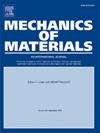Revealing the role of Al4C3 in the mechanical behavior of aluminum/graphene composites through machine learning potential-driven atomistic simulations
IF 3.4
3区 材料科学
Q2 MATERIALS SCIENCE, MULTIDISCIPLINARY
引用次数: 0
Abstract
The mechanical behavior of graphene-reinforced aluminum (Al/G) composites is strongly governed by interfacial characteristics, particularly the formation of the Al4C3 phase. In this study, a neuroevolution potential (NEP) model was developed to accurately capture the static and dynamic behaviors of Al/G/Al4C3 composites, showing excellent agreement with both first-principles calculations and experimental data. Molecular dynamics simulations based on the NEP model reveal that the presence of Al4C3 significantly enhances the tensile strength while retaining high ductility under both parallel and perpendicular loading conditions, as well as across various crystallographic orientations at the Al/Al4C3 interface. This enhancement is primarily attributed to the formation of strong covalent bonds at the interface, which substantially improve interfacial strength, as confirmed by both tensile and shear loading analyses. Furthermore, the ultimate tensile strength and Young's modulus of the composites are well predicted by the classical rule of mixtures, with load transfer identified as the dominant strengthening mechanism. These findings offer valuable insights into the reinforcing role of the Al4C3 phase in carbon-reinforced aluminum composites.

通过机器学习电位驱动的原子模拟揭示Al4C3在铝/石墨烯复合材料力学行为中的作用
石墨烯增强铝(Al/G)复合材料的力学行为受界面特征,特别是Al4C3相形成的强烈支配。在这项研究中,建立了一个神经进化电位(NEP)模型来准确地捕捉Al/G/Al4C3复合材料的静态和动态行为,该模型与第一性原理计算和实验数据都表现出良好的一致性。基于NEP模型的分子动力学模拟表明,在平行和垂直加载条件下,以及在Al/Al4C3界面的不同晶体取向上,Al4C3的存在显著提高了拉伸强度,同时保持了高延展性。这种增强主要是由于在界面处形成了强共价键,这大大提高了界面强度,正如拉伸和剪切载荷分析所证实的那样。此外,复合材料的极限抗拉强度和杨氏模量可以用经典的混合规律很好地预测,载荷传递被认为是主要的强化机制。这些发现为Al4C3相在碳增强铝复合材料中的增强作用提供了有价值的见解。
本文章由计算机程序翻译,如有差异,请以英文原文为准。
求助全文
约1分钟内获得全文
求助全文
来源期刊

Mechanics of Materials
工程技术-材料科学:综合
CiteScore
7.60
自引率
5.10%
发文量
243
审稿时长
46 days
期刊介绍:
Mechanics of Materials is a forum for original scientific research on the flow, fracture, and general constitutive behavior of geophysical, geotechnical and technological materials, with balanced coverage of advanced technological and natural materials, with balanced coverage of theoretical, experimental, and field investigations. Of special concern are macroscopic predictions based on microscopic models, identification of microscopic structures from limited overall macroscopic data, experimental and field results that lead to fundamental understanding of the behavior of materials, and coordinated experimental and analytical investigations that culminate in theories with predictive quality.
 求助内容:
求助内容: 应助结果提醒方式:
应助结果提醒方式:


